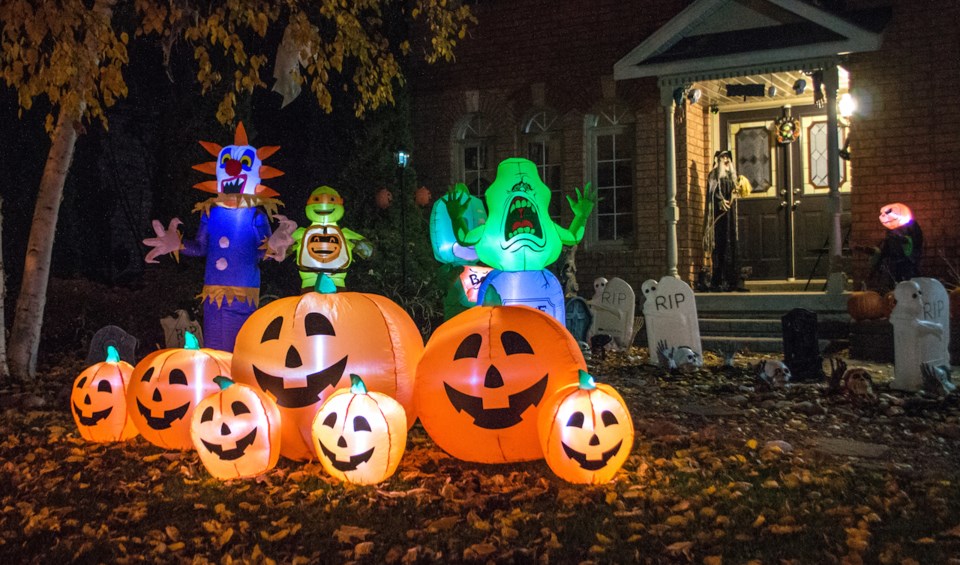ONTARIO ASSOCIATION OF FIRE CHIEFS
********************
The Ontario Association of Fire Chiefs has some advice for trick-or-treaters, party hosts and parents just in time for Halloween.
Costumes
When choosing a costume, stay away from billowing or long trailing fabric. If you are making your own costume, choose material that won't easily ignite if it comes into contact with heat or flame.
Look for costumes, beards and wigs labelled "flame-resistant" - nylon or heavyweight polyester costumes are best. Flame resistant does not mean 'fire proof'.
If your child is wearing a mask, make sure the eye holes are large enough so they can see out. Make-up and face paint are better than wearing masks which can restrict breathing and/or vision.
The best costumes are brightly coloured, flame resistant and reflective. Add reflective tape to costumes for better visibility.
Children should stay away from open flames. Be sure they know how to stop, drop and roll if their clothing catches fire. (Have them practice stopping immediately, dropping to the ground, covering their face with hands, and rolling over and over to put the flames out.)
Swords, knives and similar accessories should be made of soft, flexible material.
Trick-or-treaters should wear sturdy walking shoes that fit properly.
Trick-or-Treating
Provide children with flashlights to carry for lighting or glow sticks as part of their costume.
Remind children of pedestrian safety and rules of the road. Trick or treating should be made along one side of the street first and then the other, and that it's best to cross the street only at intersections or crosswalks. Walk and don't run. Do not cut across yards or driveways.
Make sure that children know how to call 911 or their local emergency number. Discuss with your children what they should do to call home in case of emergency.
Make your home safe for trick-or-treaters. Remove all objects around the outside of your house that could cause children to trip or fall. Turn your outside light on so children will know they can visit your home.
Children should not to eat any goodies until you see them. Make sure that your child eats dinner before they set out, so they'll be less tempted to eat their goodies along the way.
Children should stay in well-lit areas and should only visit homes that have their outside lights turned on. Children should never go inside homes or cars.
Before your children begin to eat their loot make sure you examine it first. Throw out any treats that are not wrapped, those in torn or loose packages, or any that have small holes in the wrappers. Check toys or novelty items for small parts and do not allow children under three years to play with them.
Keep pets inside and away from trick-or-treaters and lit candles, especially if they are easily frightened or become over-excited in the presence of strangers.
Go trick or treating with your children each year until they are old enough to go with a friend.
Children who are alone are vulnerable to injury and bullying by older children or may encounter a predator. When they are old enough, make sure they go with two friends or in a group, and know the routes they will be taking. Make sure they wear a watch that they can read in the dark.
Give your child a cellular phone if possible. Establish a return time and make sure children understand the importance of returning on time.
If you are driving on Halloween, be aware of children, drive slowly and enter and exit driveways and alleyways with extreme caution. Avoid driving on Halloween, if possible.
Be sure and say thank you for your treats!
Parties
Remember to keep exits clear of decorations, so nothing blocks escape routes.
If your children are going to Halloween parties at others’ homes, have them look for ways out of the home and plan how they would get out in an emergency.
Ensure that all children in your home know the location of the exits should an emergency arise.
Ensure you have installed, working smoke alarms, and practise home escape plans.
Appoint a designated driver if you attend adult Halloween parties.
Decorations
It is safest to use a flashlight or battery-operated candles in a jack-o-lantern. If you use a real candle, use extreme caution. Tea lights are a safer option and should be outdoors only.
Make sure children are watched at all times when candles are lit. When lighting candles inside jack-o-lanterns, use long fireplace-style matches or a utility lighter.
Be sure to place lit pumpkins well away from anything that can burn and far enough out of way of trick-or-treaters, doorsteps, walkways and yards. Ensure you extinguish the flame - do not leave it burning.
Avoid decorating with candles or torch lights.
Ensure that combustible Halloween decorations such as crepe paper, cornstalks, and dried flowers are kept well away from sources of heat, including light bulbs and heaters.
Keep all exits clear of decorating materials.
If using decorative lights indoors or outdoors, use lights certified by a recognized organization such as the Canadian Standards Association (CSA) or the Underwriters' Laboratory of Canada (ULC or C-UL).
Check lights for broken or cracked sockets, frayed or bare wires or loose connections. Discard damaged sets. Do not overload extension cords.
********************



